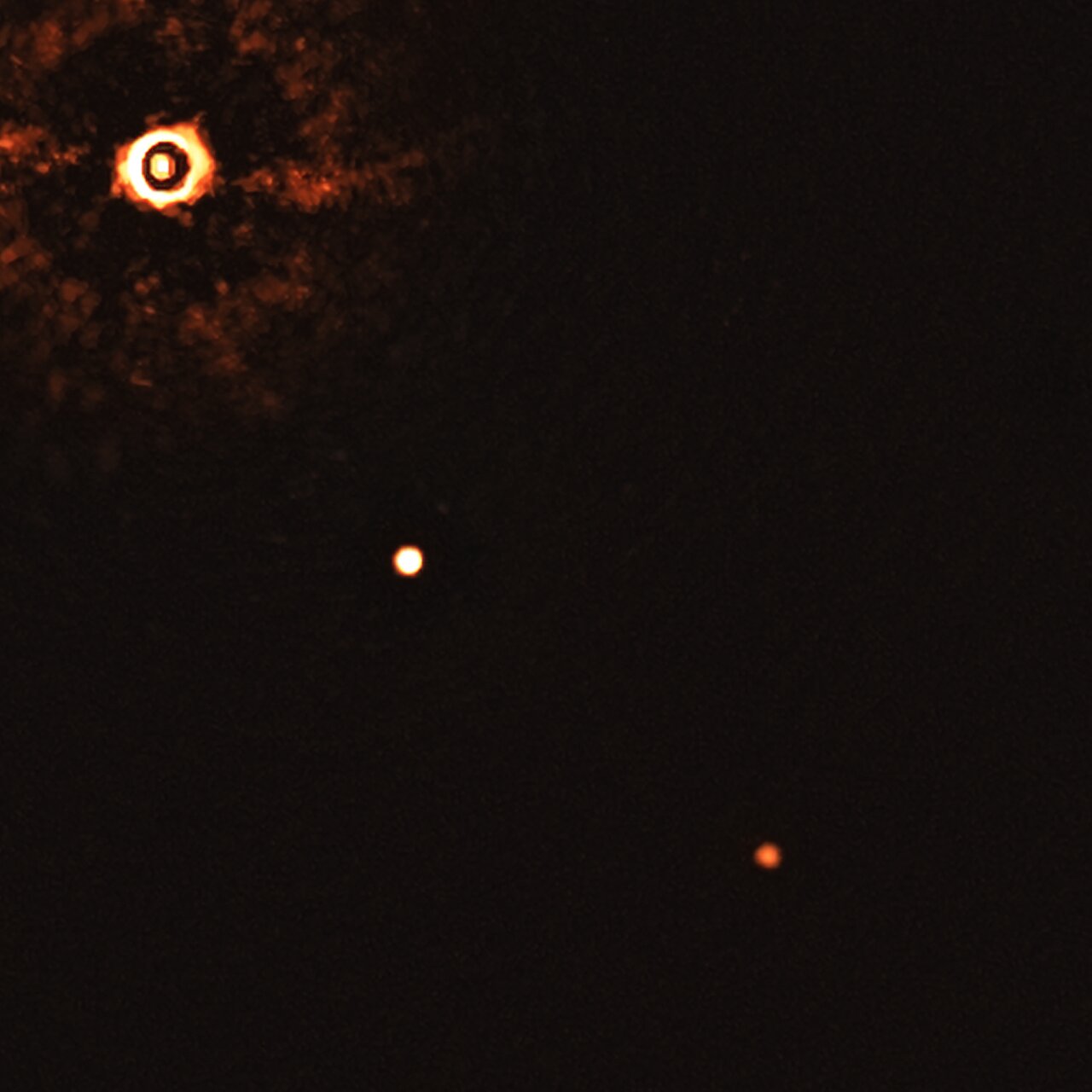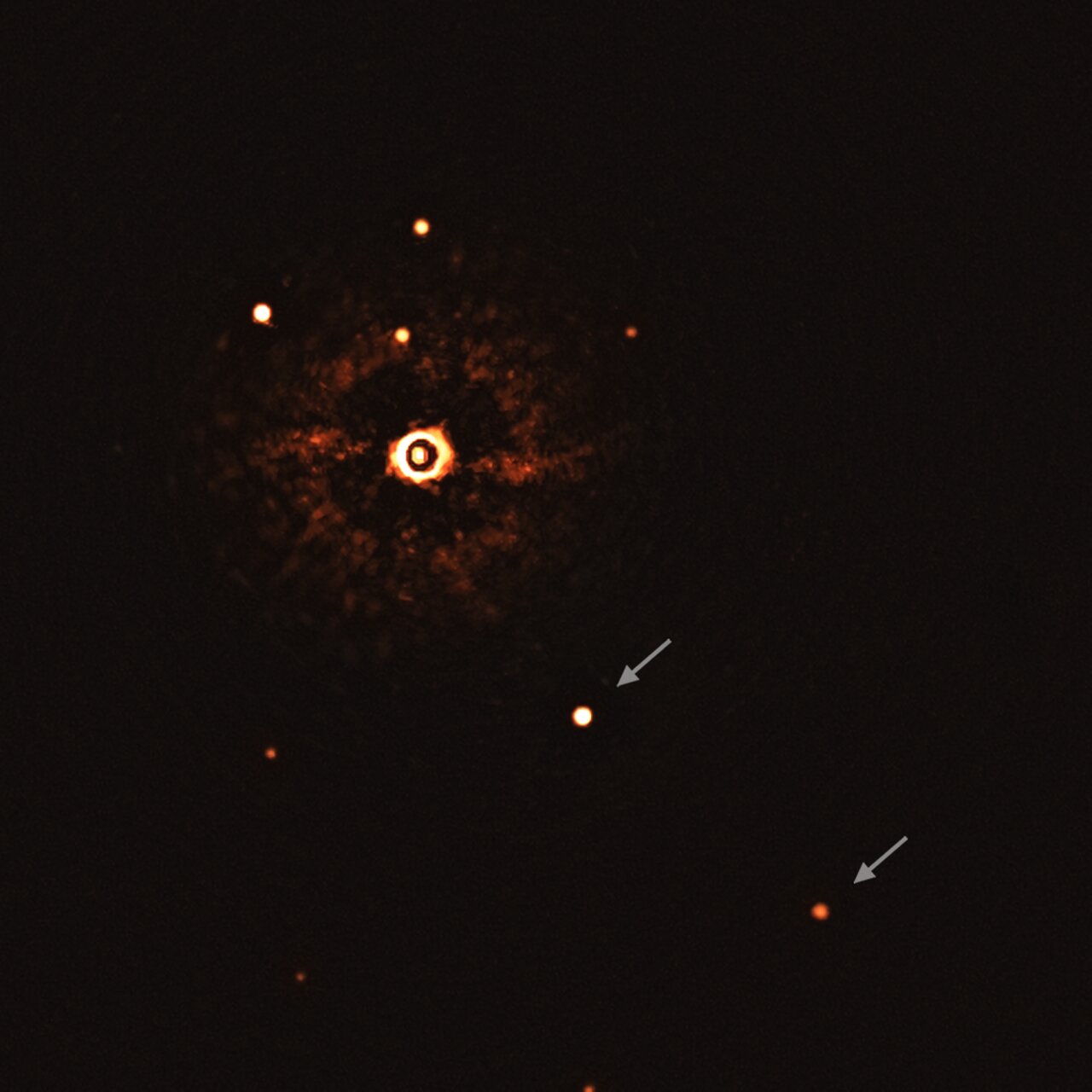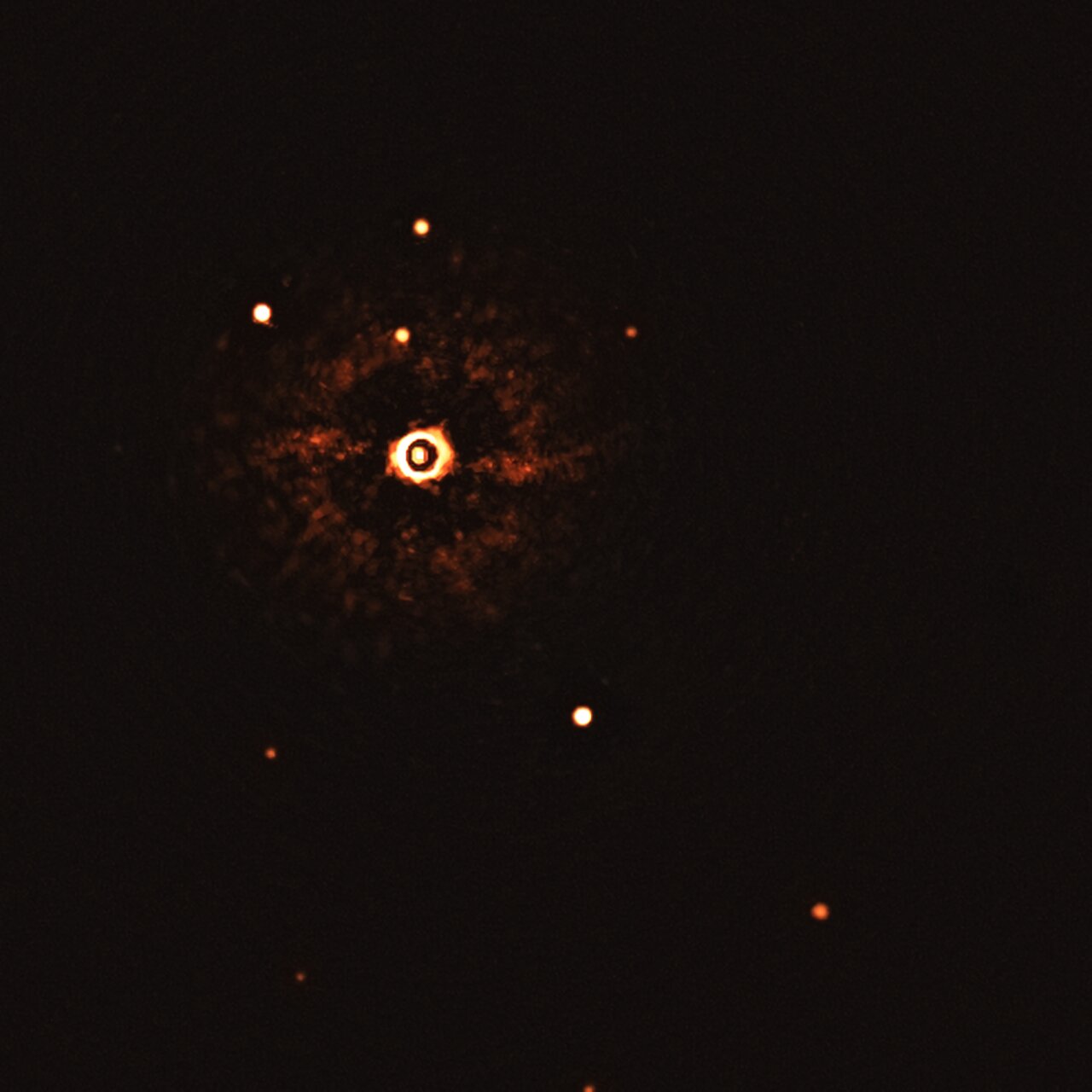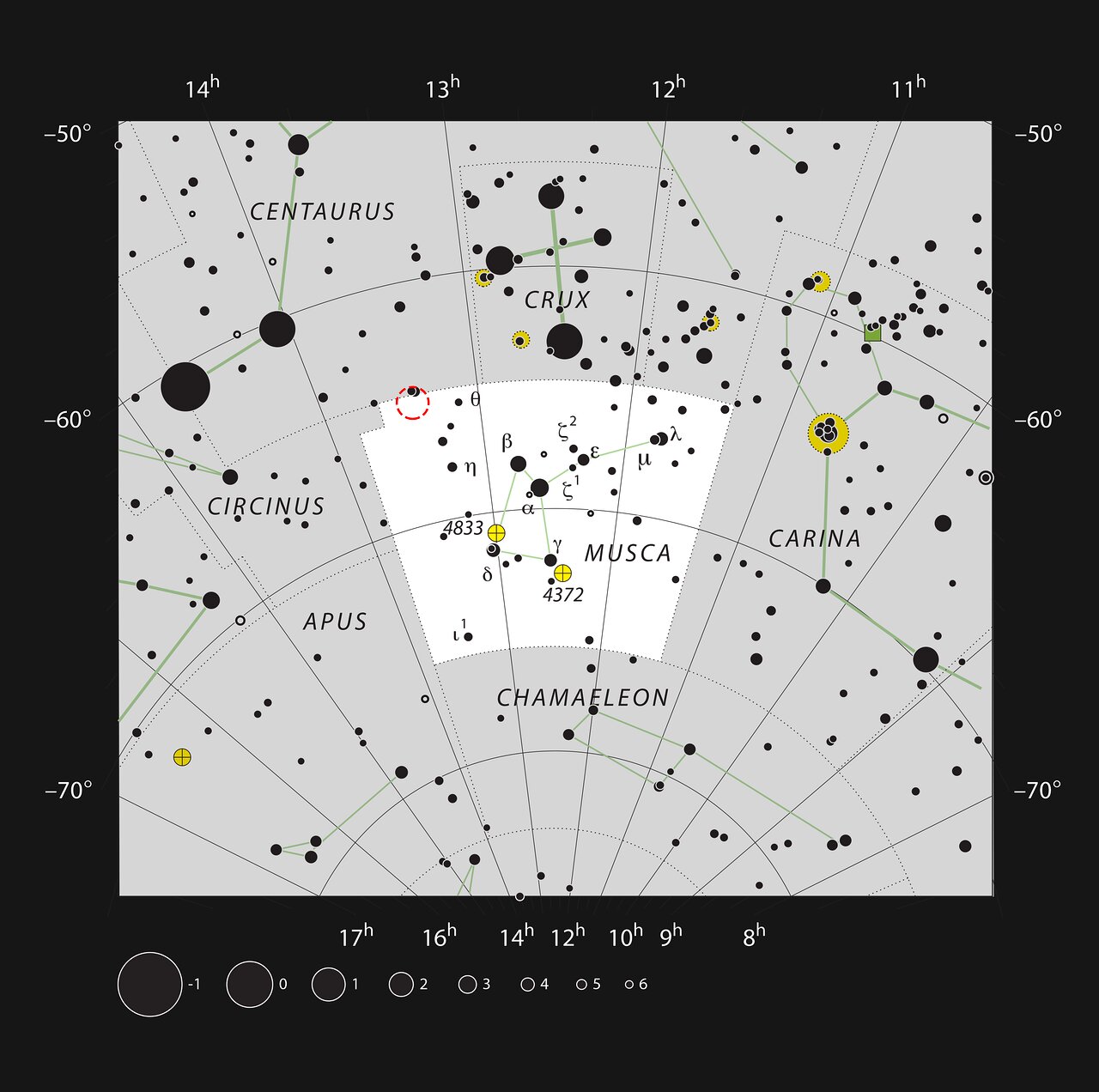It looks like you're using an Ad Blocker.
Please white-list or disable AboveTopSecret.com in your ad-blocking tool.
Thank you.
Some features of ATS will be disabled while you continue to use an ad-blocker.
32
share:
Came across this and didn't see a thread on it so thought i'd share here. It's the first ever direct image of two large exo planets around a star
similar to our own. It's pretty awesome to get to see a real image of planets outside our solar system.
www.eso.org...




www.eso.org...
The European Southern Observatory’s Very Large Telescope (ESO’s VLT) has taken the first ever image of a young, Sun-like star accompanied by two giant exoplanets. Images of systems with multiple exoplanets are extremely rare, and — until now — astronomers had never directly observed more than one planet orbiting a star similar to the Sun. The observations can help astronomers understand how planets formed and evolved around our own Sun.
Even though astronomers have indirectly detected thousands of planets in our galaxy, only a tiny fraction of these exoplanets have been directly imaged,” says co-author Matthew Kenworthy, Associate Professor at Leiden University, adding that “direct observations are important in the search for environments that can support life.” The direct imaging of two or more exoplanets around the same star is even more rare; only two such systems have been directly observed so far, both around stars markedly different from our Sun. The new ESO’s VLT image is the first direct image of more than one exoplanet around a Sun-like star. ESO’s VLT was also the first telescope to directly image an exoplanet, back in 2004, when it captured a speck of light around a brown dwarf, a type of ‘failed’ star.




Im about to boot up Elite Dangerous and try to head on over there... see if there is life...
this looks like that system that people were claiming was a rogue planet with orbiting moons that was being blacked out on maps a few years ago.
originally posted by: Lucidparadox
Im about to boot up Elite Dangerous and try to head on over there... see if there is life...
Probably have 8 legs
Wow great pictures! maybe somday we will go and see if life is there
"300 light-years away"
no way do I belive this!
we can not see a planet 300 light-years away.
and the planets look as bright as the star??
are they made of mecury?
no way do I belive this!
we can not see a planet 300 light-years away.
and the planets look as bright as the star??
are they made of mecury?
originally posted by: muzzleflash
a reply to: dug88
Question:
If the star is to the left -
How are the planet's fully lit?
Shouldn't they be crescent like in our solar system?
I'm sorry but I think these pics may be faked.
Anyone wanna try to convince me to "believe" in them?
The image was taken in infrared light, and those planets are pretty hot. So it's like heat vision.
originally posted by: wildespace
originally posted by: muzzleflash
a reply to: dug88
Question:
If the star is to the left -
How are the planet's fully lit?
Shouldn't they be crescent like in our solar system?
I'm sorry but I think these pics may be faked.
Anyone wanna try to convince me to "believe" in them?
The image was taken in infrared light, and those planets are pretty hot. So it's like heat vision.
Shouldn't one side be hotter than another tho? Earth has drastic temp changes from day to night and we are in a mild biome.
Anyways as with almost all astronomy imaging I'm pretty sure this is a composite image reconstructed.
That's my best guess.
originally posted by: buddha
"300 light-years away"
no way do I belive this!
we can not see a planet 300 light-years away.
and the planets look as bright as the star??
are they made of mecury?
We should theoretically be able to see anything emitting enough light plus in an unobstructed line of sight.
The more sensitive our eyes the more we will see. Even if it's ultra far away there will be a photon to detect tho it may be incredibly faint by our standards.
a reply to: muzzleflash
Third try at this... grrrr...
en.m.wikipedia.org...
It is a complex of different state of the art telescopes. Some do visible light and others are interferometers (radio telescopes). Those things measure heat as radio waves. So a body must be hot like that proto galaxy and brown dwarf planets.
Not visible light photo but a representation of what one would look like. Yes, real data (or they could not publish). Direct observation?? Yeah... not like most think of light and telescopes.
Hope it helps!!
Third try at this... grrrr...
en.m.wikipedia.org...
It is a complex of different state of the art telescopes. Some do visible light and others are interferometers (radio telescopes). Those things measure heat as radio waves. So a body must be hot like that proto galaxy and brown dwarf planets.
Not visible light photo but a representation of what one would look like. Yes, real data (or they could not publish). Direct observation?? Yeah... not like most think of light and telescopes.
Hope it helps!!
edit on 23-7-2020 by TEOTWAWKIAIFF because: As I said, third time and was still wrong...
originally posted by: muzzleflash
originally posted by: wildespace
originally posted by: muzzleflash
a reply to: dug88
Question:
If the star is to the left -
How are the planet's fully lit?
Shouldn't they be crescent like in our solar system?
I'm sorry but I think these pics may be faked.
Anyone wanna try to convince me to "believe" in them?
The image was taken in infrared light, and those planets are pretty hot. So it's like heat vision.
Shouldn't one side be hotter than another tho? Earth has drastic temp changes from day to night and we are in a mild biome.
Those planets' heat doesn't come from their star; it's their own internal heat.
Anyways as with almost all astronomy imaging I'm pretty sure this is a composite image reconstructed.
If I understood the article correctly, it's a direct infrared image.
So there are three important stages in extracting the direct image of a planet. First, a state-of-the-art adaptive optics system has been incorporated into the instrument to correct for the turbulent effects of the Earth’s atmosphere with the aim of delivering images as sharp as if the telescope were floating in space. Secondly, a coronagraph is used to block out the light from the star itself and increase the contrast still further. Finally, a technique called differential imaging is applied that exploits differences (the filters) between planetary and stellar light in terms of colour or polarisation. The light from the star is blocked out, leaving only the planet — although in practice the process is not as straightforward as this overview suggests!
www.eso.org...
edit on 24-7-2020 by wildespace because: (no reason
given)
Duplicate post, ignore.
edit on 24-7-2020 by wildespace because: (no reason given)
new topics
-
Krystalnacht on today's most elite Universities?
Social Issues and Civil Unrest: 4 minutes ago -
Chris Christie Wishes Death Upon Trump and Ramaswamy
Politicians & People: 31 minutes ago -
University of Texas Instantly Shuts Down Anti Israel Protests
Education and Media: 2 hours ago -
Any one suspicious of fever promotions events, major investor Goldman Sachs card only.
The Gray Area: 4 hours ago -
God's Righteousness is Greater than Our Wrath
Religion, Faith, And Theology: 9 hours ago
top topics
-
VP's Secret Service agent brawls with other agents at Andrews
Mainstream News: 13 hours ago, 10 flags -
Cats Used as Live Bait to Train Ferocious Pitbulls in Illegal NYC Dogfighting
Social Issues and Civil Unrest: 17 hours ago, 8 flags -
Nearly 70% Of Americans Want Talks To End War In Ukraine
Political Issues: 14 hours ago, 5 flags -
Sunak spinning the sickness figures
Other Current Events: 14 hours ago, 5 flags -
Electrical tricks for saving money
Education and Media: 12 hours ago, 4 flags -
Late Night with the Devil - a really good unusual modern horror film.
Movies: 16 hours ago, 2 flags -
Any one suspicious of fever promotions events, major investor Goldman Sachs card only.
The Gray Area: 4 hours ago, 2 flags -
Krystalnacht on today's most elite Universities?
Social Issues and Civil Unrest: 4 minutes ago, 2 flags -
University of Texas Instantly Shuts Down Anti Israel Protests
Education and Media: 2 hours ago, 1 flags -
God's Righteousness is Greater than Our Wrath
Religion, Faith, And Theology: 9 hours ago, 0 flags
active topics
-
University of Texas Instantly Shuts Down Anti Israel Protests
Education and Media • 26 • : CriticalStinker -
Krystalnacht on today's most elite Universities?
Social Issues and Civil Unrest • 1 • : FlyersFan -
New whistleblower Jason Sands speaks on Twitter Spaces last night.
Aliens and UFOs • 58 • : Ophiuchus1 -
SETI chief says US has no evidence for alien technology. 'And we never have'
Aliens and UFOs • 63 • : andy06shake -
Nearly 70% Of Americans Want Talks To End War In Ukraine
Political Issues • 61 • : YourFaceAgain -
Chris Christie Wishes Death Upon Trump and Ramaswamy
Politicians & People • 3 • : ImagoDei -
Hate makes for strange bedfellows
US Political Madness • 45 • : YourFaceAgain -
Post A Funny (T&C Friendly) Pic Part IV: The LOL awakens!
General Chit Chat • 7134 • : baddmove -
President BIDEN Vows to Make Americans Pay More Federal Taxes in 2025 - Political Suicide.
2024 Elections • 140 • : ImagoDei -
Sunak spinning the sickness figures
Other Current Events • 17 • : Ohanka
32
